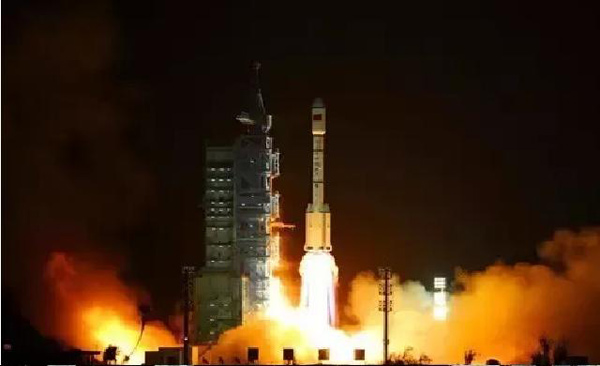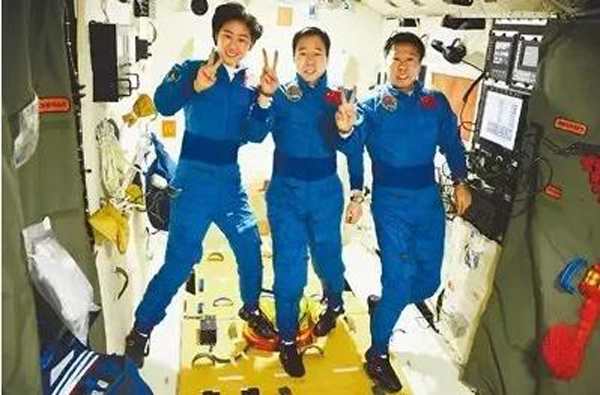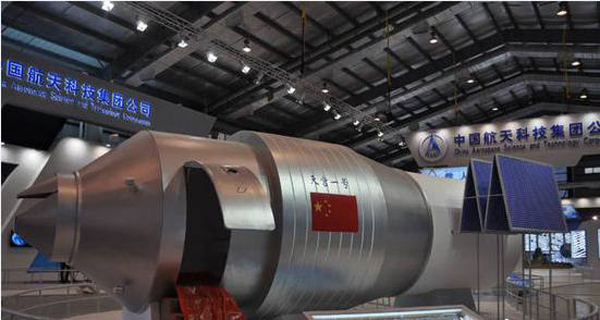当前位置: Language Tips> 双语新闻
Tiangong-1 crash: everything you need to know
我国首个目标飞行器天宫一号将再入大气层烧毁。
据中国载人航天工程办公室介绍,截至3月25日,天宫一号目标飞行器运行在平均高度约216.2公里的轨道上(近地点高度208.1公里、远地点高度224.3公里),整器结构完整,即将再入大气层烧毁。
天宫一号于2011年9月29日发射升空,先后与神舟八号、九号、十号飞船进行6次交会对接,完成了各项既定任务,为中国载人航天发展作出了重大贡献。2016年3月16日,天宫一号正式终止数据服务,全面完成了历史使命,进入轨道衰减期。
关于天宫一号的“谢幕”,这几个问题的答案是你可能想知道的:
 An artist's impression of China's first-ever space docking between Tiangong I space lab and Shenzhou VIII spacecraft in 2011. [Photo/VCG] |
The current best prediction is 1 April (no, this is not an April Fool’s joke).
目前最有力的预测是4月1日(这可不是愚人节玩笑)。
But again, because of its speed, it could be at least a day either side of that.
但是,因为天宫一号在烧毁时处于高速运转中,也可能是4月1日的前后两天。
天宫一号的残片最可能落在哪里?
The Aerospace Corporation, a nonprofit organization in the United States, estimated that the re-entry of Tiangong I would occur over Spain, France or Portugal, though an exact location is still hard to pinpoint.
美国非营利组织航空航天公司估计天宫一号可能在西班牙、法国或葡萄牙境内坠落,但是具体的地点难以确定。
我们会不会被残片砸中?
No. The chances of being hit by part of the space station are basically zero.
没必要。被天宫一号的残片击中的可能性几乎为零。
In terms of size, Tiangong-1 is only the 50th largest spacecraft to come down, and there have been no recorded deaths or injuries from people being struck by debris from any of them.
在烧毁的航天器里面,天宫一号的体积仅排在第50位,而此前没有任何记录显示有人被烧毁的航天器碎片击中并导致伤亡。
However, a highly toxic and corrosive substance called hydrazine, which is often used in creating potent rocket fuel, can potentially survive re-entry.
然而,坠落过程中可能有一种名为联氨的剧毒腐蚀性物质会残留在碎片上,这种物质常被用来制造火箭推进剂。
"For your safety, do not touch any debris you may find on the ground or inhale vapors it may emit," an online statement released by the space agency said.
国家航天局发布的网上公告称:“为了安全起见,请不要触碰地上的航天器碎片,也不要吸入碎片散发的气体。”
天宫一号在太空都做了些啥?
It was launched unmanned but was designed to be habitable, to test docking with other craft, and to be used for conducting experiments.
天宫一号发射的时候没有载人,但是设计初衷是可载人的,用来测试与其他飞船对接并进行一系列实验。
Tiangong I had completed six space rendezvous and docking missions with three visiting spacecraft. The first visit was by an unmanned spacecraft called Shenzhou VIII in November 2011, as part of China's first space docking mission.
天宫一号已经完成了6次空间交会,并和3艘飞船实现了对接。第一次对接是在2011年11月与神舟八号无人飞船对接,这也是中国首次太空对接任务的一部分。
The second and third missions were both manned: Shenzhou IX in June 2012 and Shenzhou X in June 2013. Both manned missions had three astronauts and lasted about two weeks, during which the astronauts tested the station's various systems and living conditions.
第二次和第三次对接任务都是载人交会对接任务,分别是在2012年6月与神舟九号对接,以及在2013年6月与神舟十号对接。两次载人航天任务都有三名宇航员,时间持续约两周,在这期间航天员测试了空间站的各个系统和生存条件。
天宫一号历史画面回顾:
|
 2011年9月29日,我国首个目标飞行器天宫一号在酒泉卫星发射中心发射升空,进入预定轨道。 |
|
 天宫一号与神舟八号飞船成功实现我国首次无人交会对接 |
|
 天宫一号与神舟九号飞船实现我国首次载人交会对接,航天员景海鹏、刘旺、刘洋进入天宫一号。 |


上一篇 : 这波操作太6!坐过山车尽情尖叫吧,还能给手机充电
下一篇 :
关注和订阅

电话:8610-84883645
传真:8610-84883500
Email: languagetips@chinadaily.com.cn